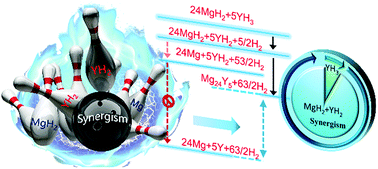当前位置:
X-MOL 学术
›
Energy Environ. Sci.
›
论文详情
Our official English website, www.x-mol.net, welcomes your feedback! (Note: you will need to create a separate account there.)
Synergism induced exceptional capacity and complete reversibility in Mg–Y thin films: enabling next generation metal hydride electrodes†
Energy & Environmental Science ( IF 32.5 ) Pub Date : 2018-04-09 00:00:00 , DOI: 10.1039/c7ee03628k Kai Fu 1, 2, 3, 4, 5 , Jun Chen 1, 2, 3, 4, 5 , Rui Xiao 1, 2, 3, 4, 5 , Jie Zheng 1, 2, 3, 4, 5 , Wenhuai Tian 6, 7, 8, 9 , Xingguo Li 1, 2, 3, 4, 5
Energy & Environmental Science ( IF 32.5 ) Pub Date : 2018-04-09 00:00:00 , DOI: 10.1039/c7ee03628k Kai Fu 1, 2, 3, 4, 5 , Jun Chen 1, 2, 3, 4, 5 , Rui Xiao 1, 2, 3, 4, 5 , Jie Zheng 1, 2, 3, 4, 5 , Wenhuai Tian 6, 7, 8, 9 , Xingguo Li 1, 2, 3, 4, 5
Affiliation

|
Much of the current research into metal hydride (MH) electrodes follows the principle that the materials should be composed of hydrogen-absorbing elements (A) and non-hydrogen-absorbing elements (B). This classical design principle, however, severely limits the potential capacities of the MH electrodes (typically <400 mA h g−1). Herein, we demonstrate a fundamentally new strategy to design high capacity MH electrodes without using B elements by inducing synergism in the dehydrogenation process. Mg24Y5 thin films, which are composed of two strong hydrogen-absorbing elements, achieve an exceptional electrochemical hydrogen storage capacity of ∼1500 mA h g−1 (5.6 wt%). All the absorbed hydrogen, including extremely stable H in YH2, can be reversibly desorbed through thermodynamic synergism. The present study provides enlightening insights to design high capacity MH electrodes and therefore enables the revival of Ni–MH batteries, and the emergence of next generation MH–air batteries.
中文翻译:

协同作用可在Mg-Y薄膜中产生出色的容量和完全可逆性:启用下一代金属氢化物电极†
当前对金属氢化物(MH)电极的许多研究都遵循这样的原理,即材料应由吸氢元素(A)和非吸氢元素(B)组成。然而,这种经典的设计原理严重地限制了MH电极的电势(通常<400 mA hg -1)。在这里,我们演示了一种根本上的新策略,即通过在脱氢过程中诱导协同作用来设计不使用B元素的高容量MH电极。由两个强大的氢吸收元素组成的Mg 24 Y 5薄膜,具有约1500 mA hg -1(5.6 wt%)的出色电化学储氢能力。所有吸收的氢,包括在YH中极其稳定的H2可以通过热力学协同作用可逆地解吸。本研究为设计高容量MH电极提供了启发性的见识,因此可以使Ni-MH电池复兴,并出现了下一代MH-空气电池。
更新日期:2018-04-09
中文翻译:

协同作用可在Mg-Y薄膜中产生出色的容量和完全可逆性:启用下一代金属氢化物电极†
当前对金属氢化物(MH)电极的许多研究都遵循这样的原理,即材料应由吸氢元素(A)和非吸氢元素(B)组成。然而,这种经典的设计原理严重地限制了MH电极的电势(通常<400 mA hg -1)。在这里,我们演示了一种根本上的新策略,即通过在脱氢过程中诱导协同作用来设计不使用B元素的高容量MH电极。由两个强大的氢吸收元素组成的Mg 24 Y 5薄膜,具有约1500 mA hg -1(5.6 wt%)的出色电化学储氢能力。所有吸收的氢,包括在YH中极其稳定的H2可以通过热力学协同作用可逆地解吸。本研究为设计高容量MH电极提供了启发性的见识,因此可以使Ni-MH电池复兴,并出现了下一代MH-空气电池。



























 京公网安备 11010802027423号
京公网安备 11010802027423号